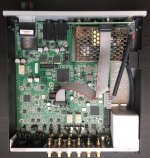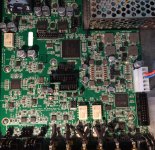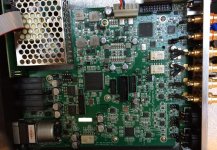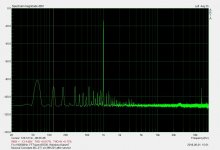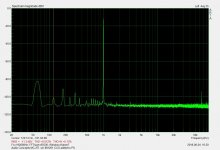Ditto my mother's 17th century (Jacob Steiner lion head) violin played in the formal dining room after a celebratory dinner.Many people do not realize how loud acoustic instruments can be ---- I have a piano in the middle of my living room. And, that thing is loud played normally. Can easily drown out the "stereo".
Another reality check is to have an opera singer do for example the 'Three Tenors' finale.
At about 2m distance ones ears crackle and distort and feet/shoes buzz...no idea of what the measured SPL was but it was loud, fiercely loud and the experience indelibles.
Pretty much any domestic audio system reproduction is a pale comparison to the above real things, and brings the question of how to reproduce that sense of realism, power and clarity.....and 'niceness/correctness'.
Dan.
Pretty much any domestic audio system reproduction is a pale comparison to the above real things, and brings the question of how to reproduce that sense of realism, power and clarity.....and 'niceness/correctness'.
That’s why 12 or 15 inch wide band pro units give the sense of realism (lot of air moving).
“Correctness” in such cases goes to realism, keeping a distance from flatness in frequency (“niceness”)
George
Fair call....the system will change immediately, and further change during the week with the filter in, and the system will change for a period after the filter is removed from circuit.Mark: Would you be willing to leave the power conditioner in for a week then take it out? I am honestly interested.
Ones ears also change during the system improvement change period and learn to 'relax' and 'take in' to the new lower distortion sound....ones ears will also readily/immediately protest when the AC PF is removed after the one week in circuit period.
After a week of back to standard condition one can make comparisons based on ones memory of the AC PF 'trial' end condition.
IME, the reversion is usually unnecessary, but is useful as confirmation of ones findings of improvements/changes wrought by AC PF.
A key finding is that the subtle differences are not always immediately apparent and therefore rapid AB comparison may not reveal subtle differences reliably for the average listener....training using On The Fly AB comparison improves this discrimination remarkably.
Dan.
Last edited:
It's going to be difficult in the average listening/living room. I like the fact my system has a volume control so I can scale the sound to the room, my ears, my mood, the time of day or night etc.....Pretty much any domestic audio system reproduction is a pale comparison to the above real things, and brings the question of how to reproduce that sense of realism, power and clarity.....and 'niceness/correctness'.
Dan.
Mark: Would you be willing to leave the power conditioner in for a week then take it out? I am honestly interested.
Sure. Will do.
Looks like the DAC3 has gone switched mode whereas the older ones were linear. But only 2 wires from the power supply so possibly local supply generation? The can over the IEC inlet is certainly large enough for an EMC filter. nothing to obviously complain about although twisting of the incoming mains wiring would have been a nice to have 
Attachments
Right. If the pics are expanded up to full size by clicking the white X in the lower left corner of each pic after clicking on initially it to open it, it is possible to see that a fair amount of real estate is power supply related. Even possible to read a lot of the part numbers.
Mark, did you figure out if they're following ess's guidelines for the midrail vref?
Do you mean AVCC or 1/2 AVCC Vref? AVCC itself doesn't have to be exactly 3.3v, there is a range, and current draw does vary somewhat with clock frequency. Appears to be up to the designer to measure it for their operational conditions. Offhand, I don't know how much AVCC current ES9028PRO needs for MCLK = 50MHz, and thus don't know if un-buffered opamp AVCC supplies can work in this case. But to answer what I think your question is, no, I have not tried to figure out exactly what Benchmark is doing for any of that or their output stage design.
Needless to say, I was very surprised, as I was not expecting any change at all. That being said there wasn't a huge problem with the tweeters before, and having it gone or reduced was not a large effect. It was still clearly an effect, and for the better.
Having been firmly in the 'if it needs a power conditioner there is a design fault with the device' camp and a 'power cord difference' disbeliever, I am still kind of trying to sort out why not even Benchmark can make a bullet-proof power supply. (I didn't change the power cord, to be clear, I am just questioning some of my old beliefs based the difference I heard with the conditioner.)
The affect of doing anything on the AC is greatly amplified on the DC. I've run into guys claiming stuff like, "you have 100,000uf worth of capacitors on the DC side, what power conditioner could possibly have an affect compared to that?" Well the reality is even a 100nf cap can make a striking difference if used correctly on the AC side, to even the best designed gear.
You have to think of power conditioning not as single thing for minor noise on the line, but something inserted into a diverse ecosystem, a big circuit with a lot going on. How and why it can benefit is pretty extensive when you realize everything in your house - and maybe neighbors - has the potential to affect what is on the line.
At the equipment side you have to think about not only how much stuff can cross the transformer's primary to secondary, but how much of it can parasitically do other things. In an SMPS parasitics can be potentially much worse. So if you can reduce the noise a lot before it gets to the equipment, you've dramatically reduced what can get in.
It gets more complicated from there. I'm just trying to inspire imaginations to visualize why it can matter. The more noise coming in, the more noise hopping into the gear, even bypassing really smart low noise designs.
Bill, leaving a power conditioner in for a week or two then removing it is the best way to experience one. What's so interesting is that when you first insert one maybe it's good enough that you get a "wow" but on some gear it's pretty subtle*. To my ears I might hear it as being extremely audible, but to someone else the differences can be so foreign to them, that they just aren't sure of anything. Then a week or two later you yank it out... that's why they realize sharply how much they miss the better sound, and what exactly it was doing. At that point you can't "unhear" what they do.
Bill, PM me your address & email, I'll send you a couple boards from my sig to try. Then you can report on how a little bit of power conditioning is in your own words.
*Despite being subtle, often people realize they can't live without one after the experience.
Last edited:
Hi Destroyer OS,
I thought that the internal power supply was a power conditioner. I often make changes to power supplies to improve their performance. Most of the time the amount of noise on the DC supplies is sharply reduced. This will be very audible to anyone who pays attention to what they are hearing. The last one I modified was in a preamp. It went from a noisy little stinker to something worthy of high dollars to buy. The output spectrum was so different that the before and after looked like two completely different products. See attached:
-Chris
Edit: The first one is after the unit was repaired and all faults corrected. It was improved a lot. The only difference is the changes made to the power supply.
I thought that the internal power supply was a power conditioner. I often make changes to power supplies to improve their performance. Most of the time the amount of noise on the DC supplies is sharply reduced. This will be very audible to anyone who pays attention to what they are hearing. The last one I modified was in a preamp. It went from a noisy little stinker to something worthy of high dollars to buy. The output spectrum was so different that the before and after looked like two completely different products. See attached:
-Chris
Edit: The first one is after the unit was repaired and all faults corrected. It was improved a lot. The only difference is the changes made to the power supply.
Attachments
Do you mean AVCC or 1/2 AVCC Vref? AVCC itself doesn't have to be exactly 3.3v, there is a range, and current draw does vary somewhat with clock frequency. Appears to be up to the designer to measure it for their operational conditions. Offhand, I don't know how much AVCC current ES9028PRO needs for MCLK = 50MHz, and thus don't know if un-buffered opamp AVCC supplies can work in this case. But to answer what I think your question is, no, I have not tried to figure out exactly what Benchmark is doing for any of that or their output stage design.
Sorry for being unclear, but their vref ciruitry in general was my question. You covered my question nonetheless. I'll be interested to see what you find if you do a bit of reverse engineering, but obviously I appreciate if you can't be bothered or don't feel like disclosing even if you can be bothered.
Appreciate the response!
Chris,
I think they both are. Noise reduction anywhere is always good. It's just fascinating how good the returns are when applied to AC. It seems like you're throwing matches at a bonfire, but somehow it really matters.
Take my DIY7297 & Antipole project. The PSU has an AC CMC on the secondary, and the amp board has a regulator on it that greatly reduces noise at the DC inlet. Both are clearly audible improvements. Does it sound better plugged into my conditioner? Yup.
I think they both are. Noise reduction anywhere is always good. It's just fascinating how good the returns are when applied to AC. It seems like you're throwing matches at a bonfire, but somehow it really matters.
Take my DIY7297 & Antipole project. The PSU has an AC CMC on the secondary, and the amp board has a regulator on it that greatly reduces noise at the DC inlet. Both are clearly audible improvements. Does it sound better plugged into my conditioner? Yup.
Problem with power conditioners is probably that doing it really right is expensive, and heavy meaning expensive to ship. A few thousand each for a DAC, amp, and power conditioner, and that's before we get to speakers. It's like, "are you crazy?!"
Many people are here to partly out of an interest to save some money and partly a hobby. The mix varies from person to person, but few are wealthy and willing to spend it freely on audio. I think those guys must hang out on another forum.
At least with an amp, someone can measure it or you can buy a handy audio measurement instrument of your own and see if you change this part or this layout then you can see the result here in this graphical measurement display.
When it comes measuring and designing power related stuff, the claim is always it sounds better. Period. You don't see measurements at the output of the amp showing changes with and without power conditioner, and measurements showing what on the power line was causing the problem. So, there is no clear, understandable link from if your AC looks like this then you should do this and your amp output should change like this, kind of stuff for people to see.
Instead it's like you throw as much broadband suppression stuff at it for every possible coupling mode you can think of or until you run out of money and then it sounds better. That's it.
No wonder people zone out and focus on the other stuff here instead.
Many people are here to partly out of an interest to save some money and partly a hobby. The mix varies from person to person, but few are wealthy and willing to spend it freely on audio. I think those guys must hang out on another forum.
At least with an amp, someone can measure it or you can buy a handy audio measurement instrument of your own and see if you change this part or this layout then you can see the result here in this graphical measurement display.
When it comes measuring and designing power related stuff, the claim is always it sounds better. Period. You don't see measurements at the output of the amp showing changes with and without power conditioner, and measurements showing what on the power line was causing the problem. So, there is no clear, understandable link from if your AC looks like this then you should do this and your amp output should change like this, kind of stuff for people to see.
Instead it's like you throw as much broadband suppression stuff at it for every possible coupling mode you can think of or until you run out of money and then it sounds better. That's it.
No wonder people zone out and focus on the other stuff here instead.
Last edited:
I appreciate if you can't be bothered or don't feel like disclosing even if you can be bothered.
!
Given all the SMT and multi-layer board I would probably have to ring out some pins to tell for sure what is connected to what. I don't necessarily want to start scratching up the pins with multi-meter probe marks until maybe the warranty has run its course, or at least until a little more of the new has worn off.
- Status
- Not open for further replies.
- Home
- Member Areas
- The Lounge
- John Curl's Blowtorch preamplifier part III
